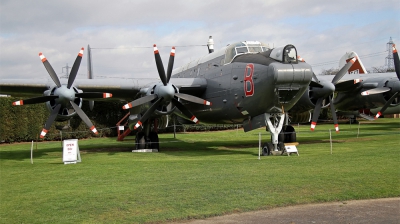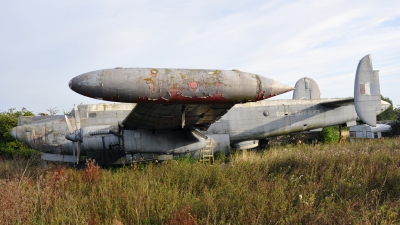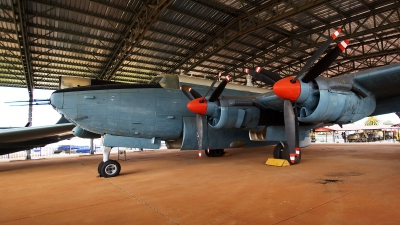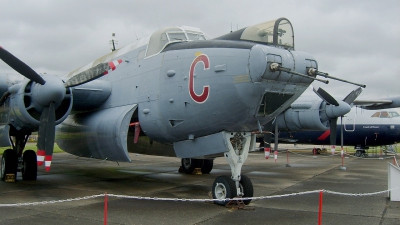Avro 716 Shackleton MR.3 Aircraft Data
By the time the last MR.2 for the RAF, WR969, was built in September 1954, Avro had completely redesigned the Shackleton for a third time, resulting in the Type 716 Shackleton MR.3, featuring a lengthened fuselage by 5ft 2in compared to the MR.2, to accommodate a duplicated crew, a modified mainplane with revised planform and the wing tip auxiliary fuel tanks. Also the twin nose-mounted 20mm cannons were reintroduced. The MR.3 featured a tricycle undercarriage with duplicated wheels on both nose and main undercarriage. To provide additional thrust during take-off two Armstrong-Siddeley (later succeeded by Bristol-Siddeley) Viper 203 turbojets were installed in the outer engine nacelles, resulting in the MR.3 Phase III.
The prototype MR.3, WR970, first flew on 2 September 1955. Flight trials by the A&AEE proved unsatisfactory mainly due to vicious stalling characteristics. Trials resumed after modifications. On 7 December 1956 WR970 crashed near Foolow, Derbyshire, after the aircraft had become inverted in cloud and the engines failed. All four crew members were killed. Alterations to the wing leading edge on the inboard section eventually solved the stalling problem. Of the initial RAF order for 52 MR.3s only 34 were built, including a replacement for WR970, this being XF730. The South African Air Force (SAAF) received eight MR.3s.
No.220 Squadron at RAF St. Eval received the MR.3 in August 1957. This unit moved to RAF St. Mawgan a month later. The second MR.3 unit at St. Mawgan became No.206 Squadron. Other MR.3 users were No.42 Squadron (St. Mawgan), No.120 Squadron (Kinloss), No.201 Squadron (St. Mawgan/Kinloss), No.203 Squadron (Luqa) and No.206 Squadron (Kinloss).
The eight SAAF Shackletons entered service with No.35 Squadron at D.F. Malan airfield, Cape Town, now Cape Town International Airport.
Shackleton MR.3 (and also the MR.2) aircraft were subjected to a series of updates, known as Phases:
Phase I:
New ASV Mk.21radar (Mod 600), Blue SilkGPI doppler (Mod 674), IFF Mk.10 and various avionics upgrades, including the Mk.10 auto-pilot and ILS. Installation of the ARI 18089 intercom system.
Phase II:
Replacement of the sonoboy Mk.1s by the Mk.1C system, Green Salad VHF homer replaced by the UHF Violet Picture, Orange Harvest (ARI 18144) ECM-equipment added, a new intercom system installed, along with further avionics updates.
Phase III:
Complete rebuild and extensive modification of the cabin, and a completely revised tactical station. A capability to release nuclear depth charges was effected. The spars were strenghtened and wings re-skinned, in fuel capacity increased by adding larger No.2 tanks, bringing total fuel capacity to 3,350 Imp gallons (24,944lb/11,314 kg). A fuel jettison system was installed as was a flare discharger. Four Griffon 58 with strengthened gear boxes were fitted as the 12 kW 28 volt DC generators required increased capacity to feed the new navigation equipment and avionics. Phase III aircraft had a Armstrong-Siddeley Viper 203 turbojet engine in the outer Griffon nacelles to assist take-off with the greater gross weight.
In addition to the internal fuel load, the MR.3 carried two wing tip tanks each with a capacity of 256 Imperial gallons (2,095 lb/ 934 kg). As with all other Shackleton variants, auxiliary fuel tanks could be carried in the bomb bay.
Note: The specifications in the tables are for the MR.3 Phase III.
The prototype MR.3, WR970, first flew on 2 September 1955. Flight trials by the A&AEE proved unsatisfactory mainly due to vicious stalling characteristics. Trials resumed after modifications. On 7 December 1956 WR970 crashed near Foolow, Derbyshire, after the aircraft had become inverted in cloud and the engines failed. All four crew members were killed. Alterations to the wing leading edge on the inboard section eventually solved the stalling problem. Of the initial RAF order for 52 MR.3s only 34 were built, including a replacement for WR970, this being XF730. The South African Air Force (SAAF) received eight MR.3s.
No.220 Squadron at RAF St. Eval received the MR.3 in August 1957. This unit moved to RAF St. Mawgan a month later. The second MR.3 unit at St. Mawgan became No.206 Squadron. Other MR.3 users were No.42 Squadron (St. Mawgan), No.120 Squadron (Kinloss), No.201 Squadron (St. Mawgan/Kinloss), No.203 Squadron (Luqa) and No.206 Squadron (Kinloss).
The eight SAAF Shackletons entered service with No.35 Squadron at D.F. Malan airfield, Cape Town, now Cape Town International Airport.
Shackleton MR.3 (and also the MR.2) aircraft were subjected to a series of updates, known as Phases:
Phase I:
New ASV Mk.21radar (Mod 600), Blue SilkGPI doppler (Mod 674), IFF Mk.10 and various avionics upgrades, including the Mk.10 auto-pilot and ILS. Installation of the ARI 18089 intercom system.
Phase II:
Replacement of the sonoboy Mk.1s by the Mk.1C system, Green Salad VHF homer replaced by the UHF Violet Picture, Orange Harvest (ARI 18144) ECM-equipment added, a new intercom system installed, along with further avionics updates.
Phase III:
Complete rebuild and extensive modification of the cabin, and a completely revised tactical station. A capability to release nuclear depth charges was effected. The spars were strenghtened and wings re-skinned, in fuel capacity increased by adding larger No.2 tanks, bringing total fuel capacity to 3,350 Imp gallons (24,944lb/11,314 kg). A fuel jettison system was installed as was a flare discharger. Four Griffon 58 with strengthened gear boxes were fitted as the 12 kW 28 volt DC generators required increased capacity to feed the new navigation equipment and avionics. Phase III aircraft had a Armstrong-Siddeley Viper 203 turbojet engine in the outer Griffon nacelles to assist take-off with the greater gross weight.
In addition to the internal fuel load, the MR.3 carried two wing tip tanks each with a capacity of 256 Imperial gallons (2,095 lb/ 934 kg). As with all other Shackleton variants, auxiliary fuel tanks could be carried in the bomb bay.
Note: The specifications in the tables are for the MR.3 Phase III.
- Country of Origin: United Kingdom
- First Flight: 2 September 1955
- Initial Service Date: 30 August 1957
- No. Built: 42
- No. In Service: 0
- No. of Hardpoints: 0
- Crew: 10 (11)
Power:
Two Armstrong-Siddeley Viper 203 at 2,500 lbf or Four Rolls Royce Griffon 58 at 2,500 hp
Weapons:
The MR.3 was capable to carry a weapons load of 15,000 lb (6804 kg) but this was reduced to 6,000 lb (2,722 kg) with fuel fuel load.
Various combinations of high explosives, Mk.30 or Mk.44 (homing) torpedoes, Mk.11 depth charges as well as nuclear depth charges such as the Mk.101 Lulu.
Provision for mine-laying and marine markers/sonobuoys.
After November 1956 the MR.2 was cleared in the bomber and colonial policing role for the carriage of 1,000lb bombs, 84 20lb fragmentation bombs, 11 Container Loading Equipment (CLE) canisters each loaded to 350lb.
After November 1956, the MR.2 was cleared in the bomber and colonial policing role for the carriage of 1,000lb (454 kg) bombs, 84 20lb (9,1 kg) fragmentation bombs, 11 Container Loading Equipment (CLE) canisters each loaded to 350lb (159 kg).
In the nose two 20mm Hispano Mk.V cannon could be fitted.
Various combinations of high explosives, Mk.30 or Mk.44 (homing) torpedoes, Mk.11 depth charges as well as nuclear depth charges such as the Mk.101 Lulu.
Provision for mine-laying and marine markers/sonobuoys.
After November 1956 the MR.2 was cleared in the bomber and colonial policing role for the carriage of 1,000lb bombs, 84 20lb fragmentation bombs, 11 Container Loading Equipment (CLE) canisters each loaded to 350lb.
After November 1956, the MR.2 was cleared in the bomber and colonial policing role for the carriage of 1,000lb (454 kg) bombs, 84 20lb (9,1 kg) fragmentation bombs, 11 Container Loading Equipment (CLE) canisters each loaded to 350lb (159 kg).
In the nose two 20mm Hispano Mk.V cannon could be fitted.
Dimensions:
| Length: | 92ft 5 in. |
| Wing Span: | 119ft 83 in. |
| Wing Area: | 1,458 sq.ft |
| Height: | 23ft 25 in. |
| Empty Weight: | 64,300 lbs |
| Max. Weight: | 108,000 lbs |
| Max. Ordnance Load: | 12,000 lbs |
| Internal Fuel: | 34,728 lbs |
Performance:
| Max. Speed: | 297 mph |
| Cruise Speed: | 190 mph |
| Normal Range: | 2,300 nm |
| Max. Range: | 3,660 nm |
Operators:
South AfricaThe South African Air Force (SAAF) received eight Shackleton MR.3 aircraft, serials 1716 to and including 1723. The Shackletons differed little from RAF MR.3s. The astrodome was placed further down the spine and the aircraft had other equipment fitted, especially after the British arms embargo had come into effect. Although the MR.3 were modified throughout their SAAF- service, they never had the Phase III modification to take the Viper jets.
United Kingdom
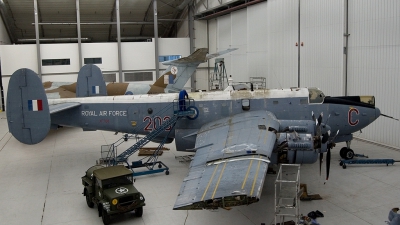
 Random great photos of the Avro 716 Shackleton MR.3:
Random great photos of the Avro 716 Shackleton MR.3:
